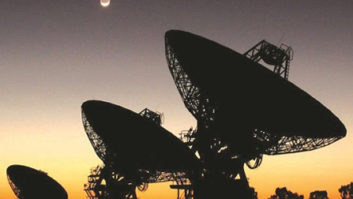Thanks for publishingthe articleon March 15 relating the experiences of an affiliate with re-pointing their downlink to the new AMC-18, used by commercial radio networks. This project could always use more publicity.

�
It is definitely worth a shot for affiliates to try re-pointing smaller downlinks, generally in the 2.8 to 3.2 meter range, to the new bird. It might just work, but affiliates need to be aware:�
- Interference from adjacent satellites, 2 degrees away, and from cross-polarized signals on the same satellite, can add up to degrade performance.
- The bigger the dish, the deeper the �null� you can achieve to avoid cross-polarized signals.
- The DSP decoder chips in most modern receivers have an error concealment feature. If one frame of audio (about 1/40 of a second) is corrupted, the chip will repeat the last 1/40 second worth of audio to �cover up� the bad data. But if two or more audio frames are bad, you�ll hear the dropout as silence, a glitch, or a squeal. So if you hear one or two dropouts, there were probably 10 or 20 more that were concealed.
If you don�t hear any glitches or squeals on the day you repoint your dish, that�s fine, but you�ve only tested the dish with the interference that was in effect onthat day. The adjacent satellites and the cross-polarized transponders on AMC-18 have dozens of other customers on them who come and go, and may increase their bandwidth or power at the drop of a hat. We in the radio industry will get no warning of these changes that could increase interference. �
�
If you elect to stay with a smaller 2.8 to 3.2 meter dish on AMC-18, be aware that there may come a day, possibly months or years from now, when a new source of interference clobbers a network signal that you want to receive. And you won�t be able to do anything about it other than ordering a larger dish, which could take you a month or two to install.
�
Since each radio network operator is on a different frequency, some networks may have interference while others might not. If Dave Ramsey sounds great but Rush Limbaugh has 50 dropouts per hour, you could start a whole new conspiracy theory! �
�
Plus, listeners will abandon your dropout-filled station to go listen to your cross-town competitor who has a 3.7 meter downlink!
�
Downlinks of 3.7 meters or bigger buy you an operational safety margin and peace of mind.
�
While the internet backup option in satellite receivers is viable, be aware that it takes 10 to 30 seconds for the web stream to buffer enough audio to produce a usable output for your listeners. �Short-lived outages of the satellite RF are not served well by backup streaming.
�
Monti is senior vice president of engineering for Westwood One in Purchase, N.Y.
�












